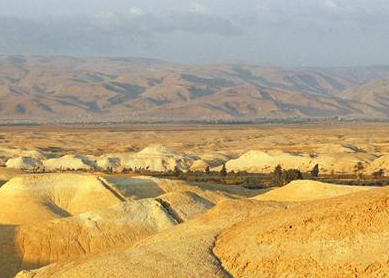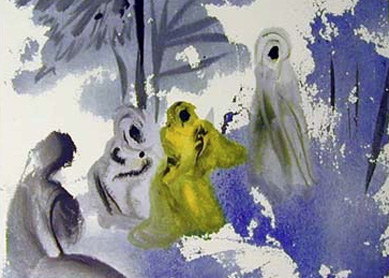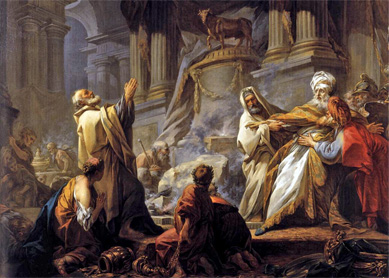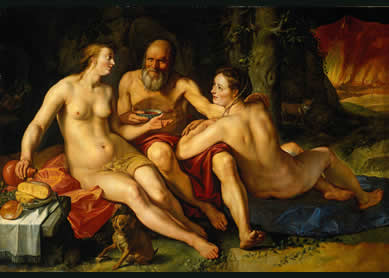Moab was a land, a people, and a kingdom located east of the Dead Sea in what is now the kingdom of Jordan. Moab as a land is first mentioned in the reign of the Egyptian pharaoh Ramses II (circa 1270 B.C.E.). The kingdom of Moab emerged in the ninth century B.C.E. and disappeared a few decades after the destruction of Jerusalem by the Babylonian king Nebuchadnezzar II in 586 B.C.E.
How similar were Israel and Moab?
In the Hebrew Bible, the relationship between Israel and Moab is an enigma. On one hand, Moab is the enemy. Moabite history begins with an ethnic joke that goes back to Lot’s incestuous relations with his daughters, implying that the similarity in Hebrew between Mo’abi (“Moabite”) and me’abi (“from my father”) was no coincidence (Gen 19:37). Moabite women lead the men of Israel into sin during the exodus (Num 25:1-2) and Solomon into sin as king (1Kgs 11:1, 1Kgs 11:7). The offspring of such unions are barred from entering the assembly of Yahweh even after ten generations, according to Deut 23:3. The Moabite king Balak hires Balaam to curse the Israelites but is foiled by a talking donkey (Num 22-24), and a later Moabite monarch, Eglon, oppresses Israel until he is assassinated by the clever Ehud from the tribe of Benjamin (Judg 3:12-30). The victorious King David is said to have systematically executed two out of every three Moabite captives (2Sam 8:2). Elisha prophesies water in the desert and victory over Moab, but when the king of Moab sacrifices his first-born son a great wrath is unleashed against the armies of Israel and Judah (2Kgs 3:27). The prophets Amos (Amos 2:1-2), Isaiah (Isa 15-16, Isa 25:10-12), Jeremiah (Jer 48), and Ezekiel (Ezek 25:8-11) all prophesy the destruction of Moab.
Other traditions present a more favorable view of Moabite-Israelite relations. The genealogy of David is traced to Ruth, that most worthy of Moabites (Ruth 4:17-18; and see Matt 1:5-6). Prior to murdering Moabite captives, David sent his father and mother to take refuge with the king of Moab while on the run from Saul (1Sam 22:3-4). Israel and Moab share a great-grandfather in Terah, the father of Abraham (Gen 11:27), and Deut 2:9-12 gives Moab a similar history to Israel, displacing an indigenous race of giants in order to claim territory given to them by Yahweh.
One of the most important inscriptions related to Israel derives from the Moabites: It is the Mesha Stela, a stela discovered at the site of Dhiban (in Jordan) in 1868. This inscription commemorates events in the reign of Mesha king of Moab, including his overthrow of Israelite rule (see the parallel account in 2Kgs 3). The language of this inscription is very close to biblical Hebrew; in fact, Israelites and Moabites probably could have conversed without a translator. The Mesha Stela also reveals a theological view of history similar to parts of the Hebrew Bible. History unfolds as good or bad events on the basis of the chief god’s anger or pleasure. Moab was oppressed by Israel because the main Moabite god, Kemosh, was angry with his land, whereas Mesha’s success was the result of Kemosh’s favor. Furthermore, the Mesha Stela attests the biblical institution of the “ban” (herem), which Mesha invokes in slaughtering all 7,000 citizens of a town aligned with Israel (compare Num 21:2; Deut 20:16-17; Josh 6:17; 1Sam 15:8).
Why does Moab matter?
From this overview, we can see that Israel and Moab shared kinship, history, language, institutions, and theology, and that this closeness often led to competition and strife between the two peoples. Being “just like us” made the Moabites dangerous to Israelite identity. Assimilation was always a threat.
The historical closeness of these two peoples also complicates our attempts to define what is “Israelite.” In the Mesha Stela, Atharot in Moab is said to be home to the tribe of Gad and to have been rebuilt by the king of Israel. Archaeologists have excavated a temple at Atharot (modern Ataruz) that contained ritual objects, including several ceramic bulls and bull-heads. Bulls are a common way to represent male gods in the ancient Near East. Yet it is difficult to determine whether this is a Moabite temple or an Israelite one, built by groups whose view of Yahweh most biblical authors would have opposed. The same problems plague the identification of Gad. In the Bible this is the name of one of Israel’s twelve tribes. But in the Mesha Stela, it is the name of a region to which both Israel’s and Moab’s kings laid claim.
Bibliography
- Routledge, Bruce. Moab in the Iron Age: Hegemony, Polity, Archaeology. Philadelphia: University of Pennsylvania Press, 2004.
- Hoerth, Alfred J., Gerald L. Mattingly, and Edwin M. Yamauchi, eds. Peoples of the Old Testament World. Grand Rapids, MI: Baker Books, 1998.
- Rainey, Anson, and R. Steven Notley. The Sacred Bridge: Carta’s Atlas of the Biblical World. Jerusalem: Carta, 2005.
- Dearman, Andrew, ed. Studies in the Mesha Inscription and Moab. Atlanta: Scholars Press, 1989.




